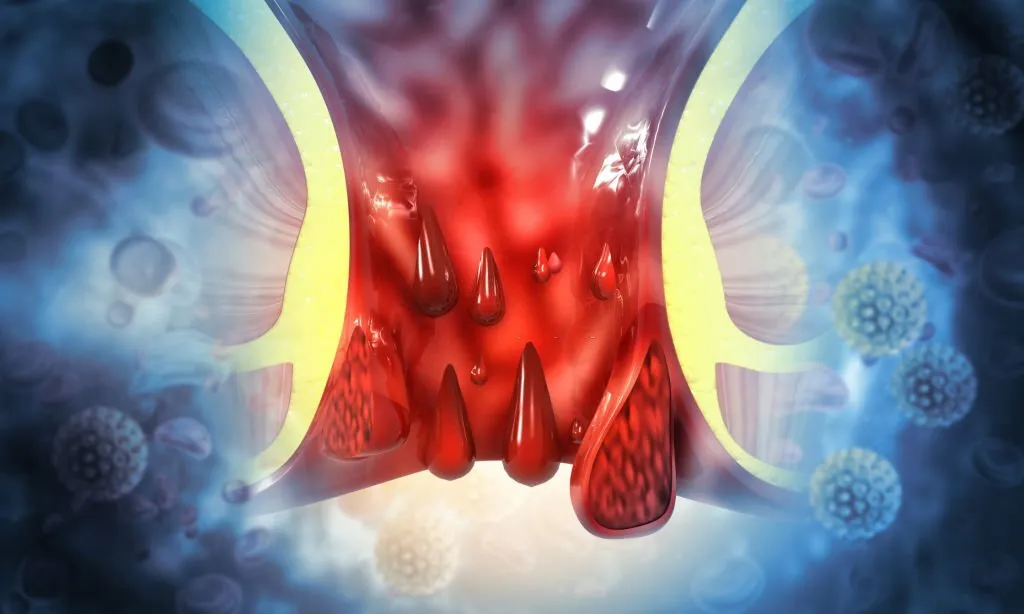Are you suffering from an itchy bottom (anus)? Or feel any pain, tenderness or soreness in your bottom every time you sit? If yes, you may have a condition called piles (medically called haemorrhoids).
Piles are enlarged and swollen veins in your anus and rectum (the final part of your large intestine). This common condition has various symptoms, causing you discomfort. Based on the grade (stage) of your piles, your symptoms may differ. Moreover, when deciding the treatment options for piles, grades and symptoms play an important role.
This article will shed light on the causes, symptoms, and treatment options for piles.
What Causes Piles?
Piles usually occur due to an increase in pressure in your lower rectum. Due to this pressure, the blood vessels of your anus and rectum will swell and bulge leading to piles.
The following actions become the causes of piles, developing increased pressure in your lower bottom:
- Experiencing difficulty during bowel movements
- Prolonged sitting on the toilet
- Dealing with persistent diarrhoea or constipation
- Being overweight or obese
- Being in the midst of pregnancy
- Engaging in anal intercourse
- Consuming a low-fibre diet
- Regularly engaging in heavy lifting
What are the Grades and the Subsequent Symptoms of Piles?
Piles are classified into four grades. Listed below are the four grades with the subsequent symptoms of piles are as follows:
Grade 1
The piles may jut into the anal canal but are not seen outside your anus. The symptoms include an itchy anus, pain in your anus, and bleeding from your rectum.
Grade 2
Like Grade 1 piles, Grade 2 piles are also internal. They may hang out of the anus when straining while passing motion. However, they return to their position after you finish using the toilet. The symptoms may include hard lumps in your anus, pain in your anus when you sit or sometimes, rectal bleeding.
Grade 3
In this grade, the piles are external and hang out from your anus when you use the toilet. However, they move inside on their own after you finish using the toilet. The symptoms may include a soft lump in your anus.
Grade 4
In this grade, the piles permanently hang down from your anus and do not move back inside on their own. The symptoms may include soft bulge, bleeding or a sensation of incomplete passage of stools.
What are the Treatment Options for Piles?
The following are the treatment options for piles:
1. Medications and lifestyle modifications
In Grade 1, typically, no surgery is required. In most cases, the following lifestyle and dietary modifications are helpful:
- Boosting dietary fibre and oral fluid intake
- Decreasing fat consumption,
- Engaging in regular exercise
- Improving anal cleanliness
- Refraining from straining and reading on the toilet
- Avoiding medications that induce constipation or diarrhoea.
Moreover, medications like pain relievers, stool softeners and corticosteroids may be helpful as this help reduce pain and inflammation of the enlarged veins. Always use these medications after consultation with your health practitioner.
2. Surgical inverventions
Though lifestyle changes and medications mentioned above can help in this grade, minor hospital treatments may be required later. These treatments option for piles are:
- Rubber band ligation– A small rubber band is placed at the base of the piles to cut off its blood supply.
- Electrocoagulation- In this procedure, a tool that passes electric current to the piles is used. Due to the current, the blood flow is stopped leading to the destruction of the excess tissue.
- Infrared coagulation- Heat from a probe inserted into your rectum to get rid of the piles.
- Sclerotherapy- A chemical is injected into the swollen veins to destroy the excess tissue.
- Hemorrhoidectomy- It is a surgery that removes the piles both external and internal ones.
3. Minimally invasive surgeries
As mentioned below, various minimally invasive surgeries (MIS) are also available as treatment options for piles including:
- LASER- Laser treatment is an MIS in which a fine laser beam is used to remove the affected piles of tissue.
- DG-HAL RAR- Doppler-guided hemorrhoidal artery ligation (DG-HALO) operations
use an ultrasound device to identify the blood vessel supplying the piles and cut it off. A rectoanal repair (RAR) may also be performed in which the piles tissue is stitched up.
- Stapling- The stapling device staples the internal piles to the wall of the anal canal to reduce blood supply and size.
- Radiofrequency ablation (RFA)- In this MIS, radio waves produce an electric current that destroys the excess piles of tissue.
In a Nutshell
Piles are nothing but enlarged veins in your anus and rectum. Causes of piles usually occur when there is constant pressure in your lower bottom. Symptoms of piles range from a lump in your anus to rectal bleeding. Treatment options for piles vary from lifestyle modification to minimally invasive surgeries. Though medicines and lifestyle changes may give you short-term relief, MIS are advantageous as they ensure fast recovery with minimal discomfort while in the procedure.
When searching for a healthcare provider that has state-of-the-art equipment, MIS, and empathetic care at its core, Smiles Hospital is your go-to option. Smiles Hospital provides minimally invasive procedures for piles and is excellent in its field. The recovery rates are high and recurrence rates are low, so you can rest assured that you are in safe hands.
It’s high time, you recognised your symptoms and took medical help! “Call 8099008800 to book an appointment or visit https://gastroenterology.smileshospitals.com/

